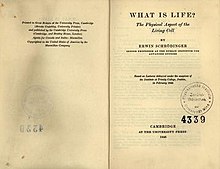 Title pages of 1948 edition | |
| Author | Erwin Schrödinger |
|---|---|
| Language | English |
| Genre | Popular science |
| Publisher | Cambridge University Press |
Publication date | 1944 |
| Publication place | United Kingdom (UK) |
| Media type | |
| Pages | 194 pp. |
| ISBN | 0-521-42708-8 |
| OCLC | 24503223 |
| 574/.01 20 | |
| LC Class | QH331 .S357 1982 |
What Is Life? The Physical Aspect of the Living Cell is a 1944 science book written for the lay reader by physicist Erwin Schrödinger. The book was based on a course of public lectures delivered by Schrödinger in February 1943, under the auspices of the Dublin Institute for Advanced Studies, where he was Director of Theoretical Physics, at Trinity College, Dublin. The lectures attracted an audience of about 400, who were warned "that the subject-matter was a difficult one and that the lectures could not be termed popular, even though the physicist’s most dreaded weapon, mathematical deduction, would hardly be utilized."[1] Schrödinger's lecture focused on one important question: "how can the events in space and time which take place within the spatial boundary of a living organism be accounted for by physics and chemistry?"[1]
In the book, Schrödinger introduced the idea of an "aperiodic solid" that contained genetic information in its configuration of covalent chemical bonds. In the 1950s, this idea stimulated enthusiasm for discovering the chemical basis of genetic inheritance. Although the existence of some form of hereditary information had been hypothesized since 1869, its role in reproduction and its helical shape were still unknown at the time of Schrödinger's lecture. In 1953, James D. Watson and Francis Crick jointly proposed the double helix structure of deoxyribonucleic acid (DNA) on the basis of, amongst other theoretical insights, X-ray diffraction experiments conducted by Rosalind Franklin. They both credited Schrödinger's book with presenting an early theoretical description of how the storage of genetic information would work, and each independently acknowledged the book as a source of inspiration for their initial researches.[2][3]
- ^ a b Margulis, Lynn. & Sagan, Dorion. (1995). What Is Life? (pg. 1). Berkeley: University of California Press.
- ^ Watson, James D. (2007), Avoid Boring People: (Lessons from a life in science), New York: Knopf, p. 353, ISBN 978-0-375-41284-4. Page 28 details how Watson came to appreciate the significance of the gene.
- ^ Julian F. Derry (2004). "Book Review: What Is Life? By Erwin Schrödinger". Human Nature Review. Retrieved 2007-07-15.